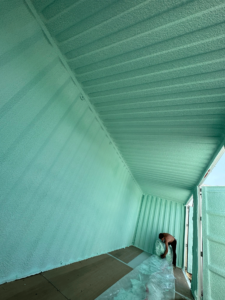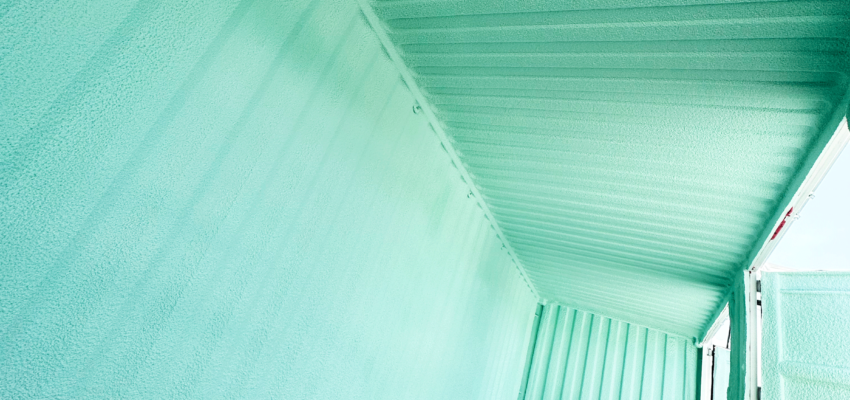Sea Can Spray Foam Insulation
Using Spray Foam Insulation for Shipping Containers
Sea Can Spray Foam Insulation Vancouver Island
Sea cans, or shipping containers, are a popular and cost-effective storage solution for both residential and commercial purposes. Whether you’re using them for storage, as a workshop, or even as a small office, adding insulation can dramatically improve their comfort and functionality. One of the best options for insulating sea cans is using spray foam insulation. In this article, we’ll explore why spray foam—specifically 2 lb. closed cell spray foam—is an excellent choice for insulating sea cans, especially on Vancouver Island.
What Is Spray Foam Insulation?
Spray foam insulation is a highly effective method for creating an airtight seal within walls, ceilings, and floors. It is applied in liquid form and expands into a thick, rigid foam that fills gaps, cracks, and cavities. Unlike traditional insulation materials, such as fiberglass, spray foam creates a seamless, impermeable layer that offers superior thermal protection, soundproofing, and moisture resistance.
There are two main types of spray foam insulation: open-cell and closed-cell. For sea cans, closed-cell foam is often the preferred option. Specifically, 2 lb. closed-cell spray foam is a popular choice for its dense and durable properties.
Learn MORE About 2 LB Complete Spray Foam Solutions
| HERE |

Why Choose 2 LB Closed-Cell Spray Foam for Sea Cans?
When it comes to insulating sea cans, 2 lb. closed-cell spray foam offers several distinct advantages:
-
Superior Insulation Properties Closed-cell spray foam has a high R-value per inch (typically around 6.5 to 7.0), meaning it provides excellent thermal resistance. This is essential for regulating the temperature inside a sea can, whether you’re storing temperature-sensitive items or creating a more comfortable space for work or living. Vancouver Island experiences a range of temperatures throughout the year, and sea cans without insulation can quickly become too hot in the summer or unbearably cold in the winter. Spray foam helps keep the temperature inside stable and energy-efficient.
-
Moisture Resistance One of the main issues with shipping containers is their vulnerability to moisture and humidity, especially in coastal climates like Vancouver Island. Closed-cell spray foam is highly resistant to water, preventing condensation from forming inside the container. By preventing moisture buildup, spray foam helps protect your belongings from mold, mildew, and rust, extending the life of the sea can and its contents.
-
Air Tight Seal One of the key benefits of spray foam insulation is its ability to seal off air leaks. This is crucial in a sea can, as they often have gaps, seams, and vents that allow air to pass through. Spray foam expands to fill every nook and cranny, creating an airtight barrier that prevents heat loss in the winter and keeps cool air inside during the warmer months. This makes your sea can more energy-efficient and comfortable to use year-round.
-
Soundproofing Sea cans can sometimes echo or amplify sound, which may be an issue if you’re using the space as an office, workshop, or living area. The dense nature of closed-cell spray foam provides soundproofing benefits, reducing noise transmission and helping to create a quieter environment inside.
-
Structural Integrity Closed-cell spray foam not only insulates but also adds strength and rigidity to the structure of the sea can. Over time, containers can be subject to dents and deformation from external forces. Spray foam can help strengthen the walls, providing additional support and making the container more durable.
-
Long-lasting Performance Unlike other forms of insulation that can settle, shift, or degrade over time, spray foam stays in place and retains its effectiveness for the long haul. Once applied, it forms a permanent barrier that won’t need to be replaced or adjusted for years. This makes it a low-maintenance, long-term solution for sea can insulation.
How is Spray Foam Applied to a Sea Can?
The application of spray foam insulation to a sea can is typically done by professional installers. Here’s an overview of the process:
-
Surface Preparation Before applying the spray foam, the surface of the sea can needs to be cleaned and prepared. This may involve removing any dirt, rust, or old coatings that could prevent the foam from adhering properly. The installers will also check for any structural issues that need to be addressed before insulation.
-
Spraying the Foam Once the surface is prepared, the spray foam is applied using specialized equipment. The foam is sprayed as a liquid that expands rapidly, filling every gap and crack in the container. For sea cans, 2 lb. closed-cell spray foam is often applied in layers to ensure even coverage and complete sealing.
-
Curing Time After the foam is applied, it needs some time to cure and harden. This typically takes about 24 to 48 hours. During this time, the foam solidifies into a dense, rigid layer that will provide superior insulation and protection.
-
Finishing Touches Once the foam has cured, the installers may trim any excess foam, ensuring that the insulation is flush with the walls and doesn’t obstruct doorways or other features inside the container.
Benefits of Using a Professional Spray Foam Insulation Service
While it may be tempting to try DIY spray foam installation, it’s always recommended to hire a professional service to ensure the job is done correctly. Experienced professionals, like those at Vancouver Island Spray Foam Services, have the necessary equipment and expertise to apply the foam evenly and efficiently. Additionally, they can ensure that all safety measures are followed and that the foam is applied to the correct thickness for optimal performance.
Conclusion
Spray foam insulation is an excellent choice for improving the energy efficiency, comfort, and durability of your sea can on Vancouver Island. With the benefits of 2 lb. closed-cell spray foam—such as superior thermal resistance, moisture protection, and air sealing—your sea can will be better equipped to handle the island’s coastal climate. Whether you’re using the sea can for storage, as a workshop, or as an alternative living space, investing in spray foam insulation is a smart, long-term solution that will make your container more functional and comfortable.
